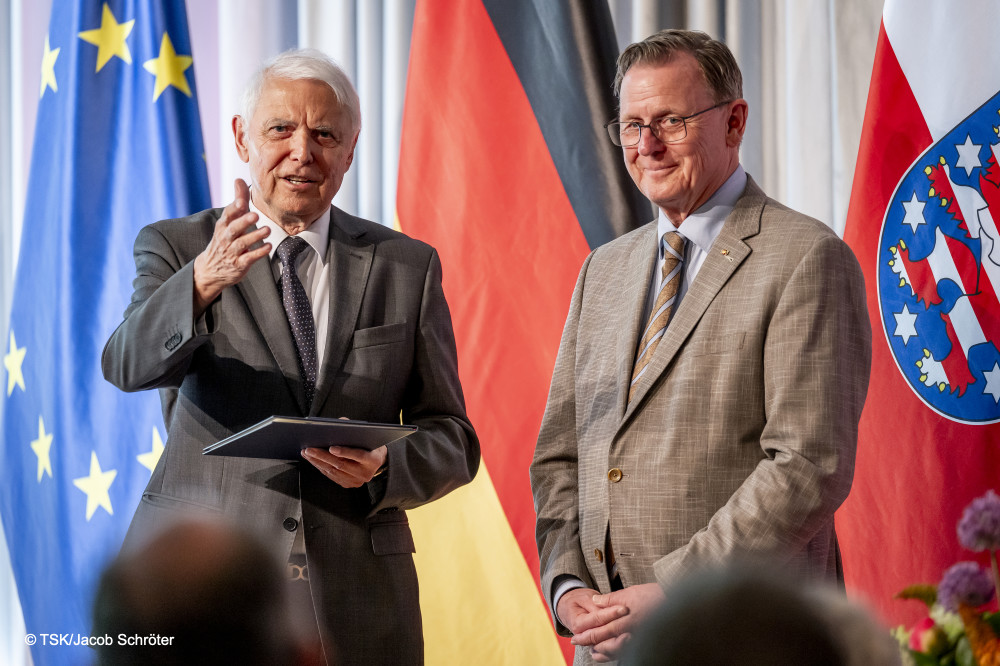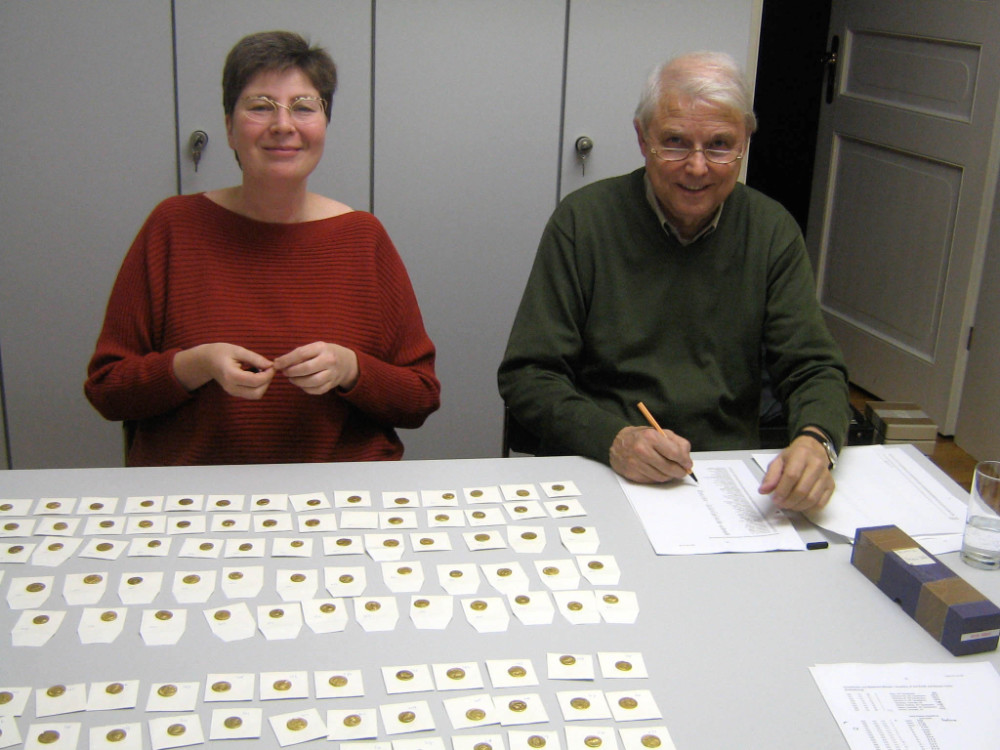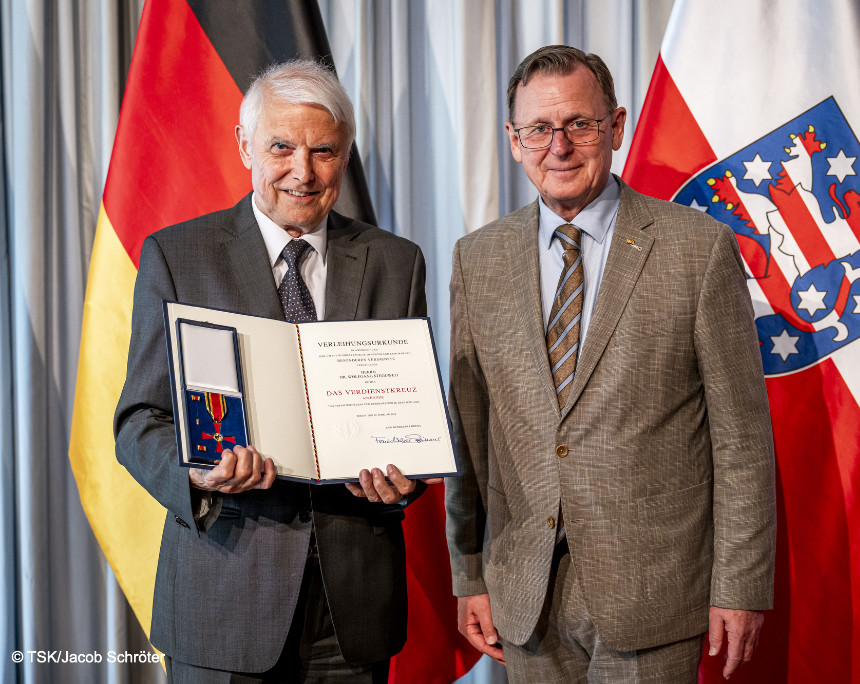Wolfgang Steguweit Receives the Federal Cross of Merit
by Ursula Kampmann, translated by Maike Meßmann
Wolfgang Steguweit is one of Germany’s most distinguished and dedicated numismatists. His commitment has now been honoured by the German Federal President Frank-Walter Steinmeier by awarding him the Cross of the Order of Merit of the Federal Republic of Germany, which is colloquially known as the Federal Cross of Merit.
Content
The award was presented on 11 May 2024 by Bodo Ramelow, Minister-President of Thuringia, on behalf of the Federal President. He honoured the numismatist with the following words: “I would like to thank Dr Wolfgang Steguweit for 40 years of active museum work, which has always been linked to his passion for medals on the one hand and for cultural and art history on the other. Given his extensive voluntary work, Dr Steguweit must be considered an absolute blessing for Gotha and Thuringia. For his life’s work, which is characterised by unparalleled dedication, commitment and a deep understanding of art, culture and history, he has been awarded the Cross of the Order of Merit of the Federal Republic of Germany.”

After receiving the Cross of Merit from Minister-President Bodo Ramelow, Wolfgang Steguweit expressed his thanks. Photo: Thüringer Staatskanzlei / Jacob Schröter.
We at CoinsWeekly are very pleased that Mr Steguweit has received this honour. After all, Wolfgang Steguweit is one of those people who have achieved a great deal not only for numismatics, but also for the growing together of East and West Germany.
Born During the War, Grown Up in the GDR
Wolfgang Steguweit was born in the penultimate year of the war, on 30 January 1944, in Königberg, todays Kaliningrad in Russia. Together with his mother Gerda, he ended up in the small German village of Karstädt near Ludwigslust, to which his father returned from Belgian captivity in 1947, ill and prematurely aged, to re-join his family. He was to die as early as in 1959 as a result of the war, leaving his wife to look after their child. She did so in the hardships of the post-war period as a worker in an agricultural production co-operative in East Germany.
In those days, many people had dreams and escaped from the harsh reality through music, literature or film. For Wolfgang Steguweit, it was coins that transported him to other worlds. After all, he had already discovered coin collecting at primary school: “On the way to school one day, I had a key experience that was to have a lasting effect on my life. I found a copper coin in the bushes by the side of the road. It was a halfpenny of the British King George VI… with a sailing ship on the reverse. … Since then, coins have been the vessel that has allowed me to explore my dreams.”
But at that time, it was not easy to make numismatics a profession. In East Germany, the state influenced what you studied. So, after leaving school in 1962, Wolfgang Steguweit studied art history, art education, German studies and education in Dresden. Not because this was his dream programme, but because in the early 1960s only teachers were allowed to enrol in such ‘superfluous’ subjects as art history.
Somehow, the committed and independent-minded young man navigated through the impositions of an authoritarian state that tried to (mis)use him for its own ends. His thick file at the Ministry of State Security (Stasi), which he was only allowed to read after the reunification, explained many things that had seemed incomprehensible to him during the GDR era. But he was lucky in one respect: The position as supervisor and curator of the numismatic collection of the castle museum in Gotha was vacant – and the director wanted the young numismatist. After a long waiting period as a teacher, Wolfgang Steguweit was allowed to take on this position.
A Life for Numismatics
It was then that Wolfgang Steguweit was finally able to follow his calling and begin his ‘real’ life. On 1 September 1971, he took up his post at Friedenstein Castle in Gotha with a quite reasonable salary of 799 marks. Under conditions that are almost unimaginable today, he set up exhibitions, published and expanded the collection through acquisitions. Thanks to Wolfgang Steguweit, the Gotha numismatic collection gained the staggering amount of 14,646 objects, for which about 130,000 GDR marks were allotted.
In 1980, he received his doctorate with a thesis on the history of the Gotha mint in the second half of the 17th century. But, of course, this was only the tip of the iceberg of his academic work. Although he was routinely banned from attending congresses in Western countries by GDR authorities, he expanded his network by visiting numerous eastern European nations. He also met many important numismatists from democratic countries there, who gladly accepted his invitation to give a lecture in Gotha.
In consultation with the Ministry of Culture, the Director General of the National Museums in Berlin appointed Wolfgang Steguweit Director of the Numismatic Collection in 1988. This meant that he was in exactly the right place to sift through museum holdings and secure the most important treasures for the numismatic collections of the new federal states during the liquidation of the GDR’s state-owned foreign currency company called ‘KoKo’. 1,500 rarities owe their place in public collections to Wolfgang Steguweit’s commitment, who also sacrificed his free time to go through the holdings of the ‘KoKo’. He took great care to ensure that these holdings were catalogued separately, so that, in the event of justified claims for restitution, the items could be returned to their original owners.
Almost even more remarkable and very characteristic was a step Wolfgang Steguweit took in 1992. He resigned from his position as Director of the Numismatic Collection of the National Museums in Berlin in order to fulfil his duties as Deputy Director and Chief Curator until his retirement in 2009. There are only a few people out there who value their work more than being rewarded with high offices and honours.
A Love of Medals
Those who read the name Wolfgang Steguweit today, will immediately think of medals. After all, medals are very close to this scholar’s heart. This is not only reflected by his academic work, but also by his other activities. In 1991, he founded the Deutsche Gesellschaft für Medaillenkunst (German Society for Medallic Art), which he chaired for many years. He was a delegate for Germany at the FIDEM Congresses and organised such a congress himself in Weimar in 2000. He is the initiator of the Hilde Broër Prize for medallic art, and set up the literature series “Die Kunstmedaille der Gegenwart in Deutschland” (The contemporary art medal in Germany).

Appraising the aurei from Gotha’s collection: Wolfgang Steguweit and Ursula Kampmann make for an excellent team. Photo: Frank Berger.
A Few Personal Remarks and Memories of Wonderful Hours in Coburg
I had known Wolfgang Steguweit by sight for many years, but it was ‘only’ in 2007 that I really got to know him. At that time, he called me. In a tone that could be described as conspiratorial, he asked me to keep his call confidential. And then he told me an incredible story about some heavy boxes of coins that had turned up at Coburg Castle. They contained, for one, the entire Ducal Collection of ancient coins from Gotha and, secondly, the collection’s most precious modern coins, which had to be taken to the West under unclear circumstances before the end of the war. Wolfgang Steguweit wanted to return the coins to the Gotha numismatic collection and needed someone with enough expertise to make a quick appraisal, but who had no interest in advising the owners to sell the coins at auction. And the coins would have made a splendid auction! I had retired from the coin trade a few years earlier. That is why he chose me.
So I travelled to Coburg in early December, through a vicious snowstorm. We had two days to appraise the about 16,000 coins and medals. It was hard work that Frank Berger, Wolfgang Steguweit and I did in a small, slightly overheated room in the Coburg forestry office. It was there that I experienced Wolfgang Steguweit’s iron will. We never discussed whether we could do it – we only discussed how to do it. With a great deal of humour and energy, but always with a clear goal in mind, he gathered the information that would become the basis for the later repatriation.
Today, these coins are back in Gotha. After three years of tough negotiations, the required funds were raised by two patrons –Fritz Rudolf Künker and Friedrich Popken –, as well as the federal state of Thuringia and the Cultural Foundation of the German Federal States. The Ernst von Siemens Art Foundation also came on board with long-term pre-financing.

Detail of a medal by Nikolaus Seeländer commemorating the foundation of the Gotha numismatic collection by Duke Frederick II in 1713. – One of Wolfgang Steguweit’s favourite pieces that were brought back to Gotha. Photo: KW.
Gratulamur!
Wolfgang Steguweit’s Federal Cross of Merit symbolises much that he has achieved in his life. It stands for his commitment to preserving German numismatic heritage for the public. It symbolises his achievements in creating new, contemporary cultural assets. For me, however, it also stands for his ability to break down barriers in our minds in order to work together towards a common goal.
We at CoinsWeekly would like to offer our congratulations! We are delighted for the recipient and about the fact that the German President has honoured someone who loves numismatics as much as we do!






